#they shot mecha shinzo abe with this
Explore tagged Tumblr posts
Text
it's not the greatest stats-wise but the best weapon in armored core six so far is the sweet sixteen
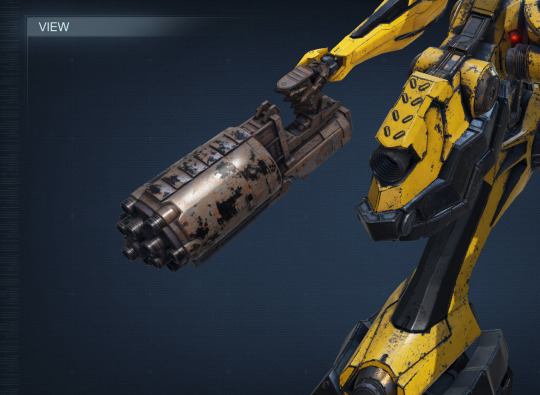
there are certainly stronger shotguns but why would you use them when you could take someone's ass to the contraption. what the fuck is this thing
#it doesn't have sixteen barrels so i assume it's named after the number of closed caskets you'll be spread between#if it goes off pointed anywhere near your approximate location#dibi#armored core#they shot mecha shinzo abe with this#also i just spent two hours on a 118 layer decal HELP
568 notes
·
View notes
Text
Can anyone recommend me a steampunk-type setting story where it has more cyberpunk-y vibes. I want something with more thought than "slap brass paint and gears on it.¹"
Like swap in colonialism or robber barons for the megacorps.
I mean the massive corruption and the wealth inequality is already there.
¹ THE 19TH CENTURY WAS THE RISE OF SYNTHETIC DYES. THEY INVENTED MAUVEINE. IF ANYTHING IT SHOULD BE JUST AS HOT PINK AS CYBERPUNK IS. I WILL DIE ON THIS HILL. AND DON'T FORGET THE ARSENIC GREEN.
#steampunk#cyberpunk#do I want a plot where Rockefeller gets shot with a doohickeymadoodle like Shinzo Abe? Maybe???????#who am I kidding of course I want a plot where Rockefeller gets shot with a doohickeymadoodle#Opium Wars but the Chinese have a giant mecha for some reason#*hits pop culture with a baseball bat* STOP LETTING PEOPLE WHO WOULD RATHER DIE THAN READ A HISTORY BOOK WRITE HISTORICAL SETTINGS
15 notes
·
View notes
Text
Shin Godzilla (2016)

Trailer
It’s funny that I approached two seminal deconstructive works - Alan Moore, Dave Gibbons, and John Higgins’s Watchmen and Hideaki Anno’s Neon Genesis Evangelion - before I had experienced the media and the works that they were respectively deconstructing. I read Watchmen in high school, at a time when I was mostly reading Marvel Comics’s output. I didn’t have the frame of reference to understand how Moore, Gibbons, and Higgins were taking apart the idea of the lone vigilante motivated by a traumatic childhood or the godlike superman. I only realized the commentary Watchmen provided after the fact, and reading the commentary alongside the original text became a sport of its own.
Similarly, when I watched Neon Genesis Evangelion for the first time in college, I had not seen the mecha anime that Evangelion was examining. Just as Watchmen took apart the specific tropes and character archetypes of comic books through parallel characters (Dr. Manhattan is Superman, Nite Owl and Rorshach are Batman, the Comedian is Captain America, Silk Spectre is Black Canary), so was Evangelion dissecting the archetypes found in the mecha anime genre. (Shinji Ikari is the ace teenage pilot, like Amuro Ray from Mobile Suit Gundam, Rei Ayanami is the shy, mysterious love interest who is obedient to the protagonist, Asuka Langley Soryu is the rival, hot tempered love interest and ace pilot.)
It’s striking that both deconstructive works found their analytical powers in presenting “real world” consequences of their genre’s respective and specific tropes through mental illness. Only someone suffering from severe mental health issues could attempt to wage a one-man war on crime by putting on a mask and fighting in the streets. A more realistic version of Batman, Moore, Gibbons, and Higgins, posited, would have to look more like Rorshach. Similarly, a scientist who is able to build giant robots that defend mankind would be even more cynical and monstrous than Astro Boy’s Dr. Tenma; he would look more like Gendo Ikari, who is incapable of maintaining any human relationships and treats everyone around him like dirt.

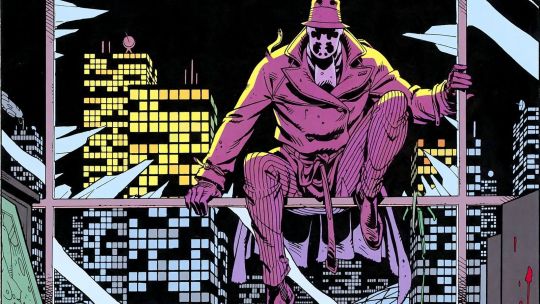
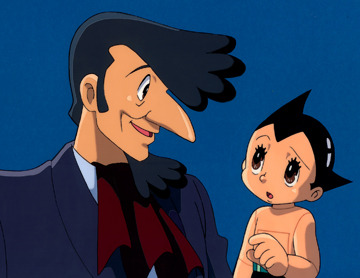

I revisit Evangelion more often than I revisit Watchmen, though Moore and Anno have made it difficult to follow their creative output. Moore’s return to the independent comics publishers to pursue more explicitly sexual, violent, and sexually violent works like Lost Girls, Neonomicon, The Courtyard, and Providence, while Anno’s attempt to retell Evangelion in a new context through the Rebuild of Evangelion movies has stalled with increasingly long delays. Evangelion 1.0: You Are (Not) Alone was released in Japan in 2007, while Evangelion 2.0: You Can (Not) Advance was released in 2009. Evangelion 3.0: You Can (Not) Redo was released in 2012, while production on the final Rebuild of Evangelion film has only barely begun.
Part of the delay in the Rebuild of Evangelion project was Anno’s and Shinji Higuchi’s involvement in Shin Godzilla, which is also known as Godzilla: Resurgence. Anno was contacted to direct Shin Godzilla after falling into depression after completing Evangelion 3.0. Principal photography for Shin Godzilla began in 2015, and the film was released in 2016. It re-positioned Godzilla as a creepy, scary monster, a force of man-made disaster that would serve as allegory for the Japanese triple disaster of the Tohoku earthquake and the subsequent tsunami and the Fukushima Daiichi nuclear disaster of March 2011. (American films will allude to traumatic events in fiction, but more often than not American films will outright try to recreate the traumatic events. You might see Batman vs. Superman: Dawn of Justice, for example, reference the September 11, 2001 terrorist attacks on the World Trade Center, but you’re more likely to see movies that try to recreate that historical event, thereby compressing and distorting history. There’s actually more intellectual honesty in allegorical approach than trying to make a film based on a true story.)


vs.
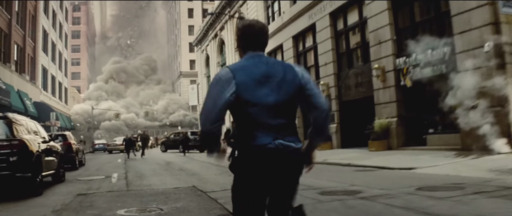

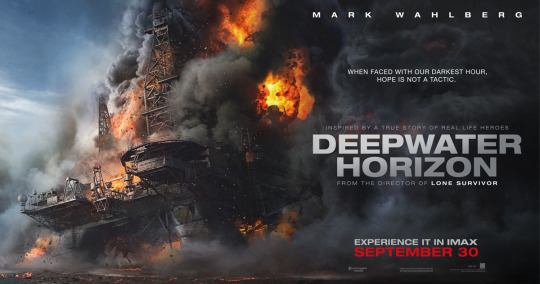
Furthermore, while Anno and Higuchi criticized the Japanese government’s slow response to the disasters of March 2011 through the way actions to counteract Godzilla’s advance would have to flow from the theatre of action up to sub-commanders to deputy ministers to cabinet ministers to the prime minister, who would make a decision that would have to then travel down the same of communication chain before it was communicated, Anno and Higuchi showed great optimism and faith in Japanese infrastructure. Politicians who could be interpreted as weak or concerned about preserving their reputation could be reinterpreted as figures who are willing to give up power so the country could have a fresh start in the aftermath of Godzilla’s cataclysmic visit, figures who are willing to sacrifice their honor for the country’s sake, or figures who are willing to sacrifice their reputations so they could give citizens the best information they had at the time. There’s a lot of moving from one conference room to another that might seem unnecessary to the impatient viewer, but the conversations in those conference rooms are what lead to solutions.
It helps that Anno and Higuchi find sharp angles to film what could have been devastatingly dull conversations in these conference rooms.



Finding these new angles to show men and women working together to solve the Godzilla problem places the emphasis on their humanity and professionalism. Godzilla will not be defeated by sheer force of Japanese or American arms. While Anno and Higuchi uses gorgeous compositions to show the futile attacks on Godzilla by the Japanese Self-Defense Force, they also show the futility of these attacks in widescreen, captivating shots that also emphasize Godzilla’s magnitude.


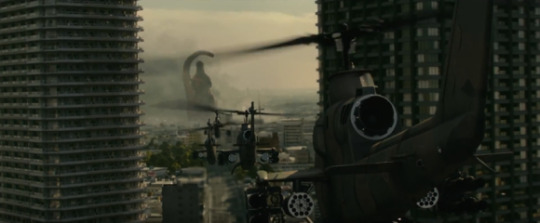



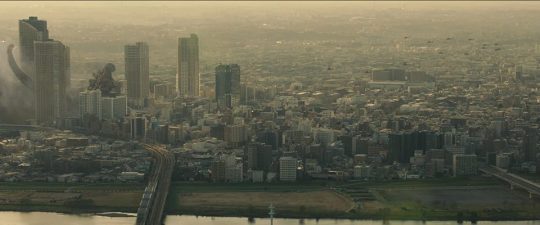
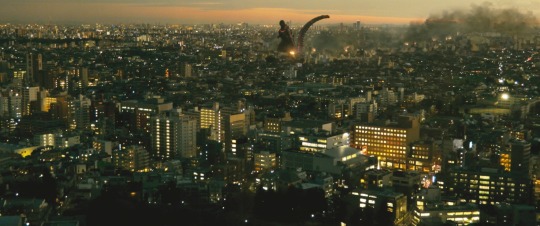

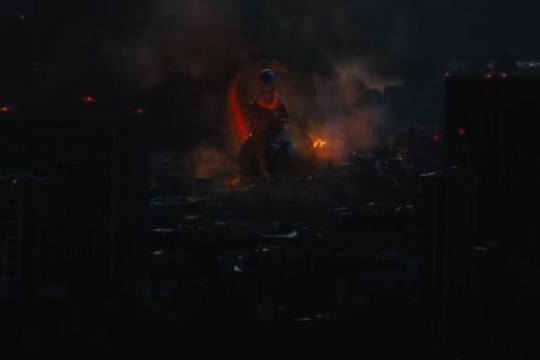
Instead, Godzilla can only be defeated when Japanese industrial acumen, business connections, and American arms are combined to form a strategy that requires self-sacrifice and precise timing, hallmarks of Japanese industrial culture. The hope for Japan won’t be found outside the country. Conventional arms cannot defeat Godzilla. Outlandish non-conventional weapons, like MASER cannons or Mechagodzillas, aren’t feasible. Instead, the hope for survival and the future can be found in Japanese systems like its trains and its industries. It’s subtly nationalist in a way that matches resurgent Japanese nationalism under Prime Minister Shinzo Abe’s regime.
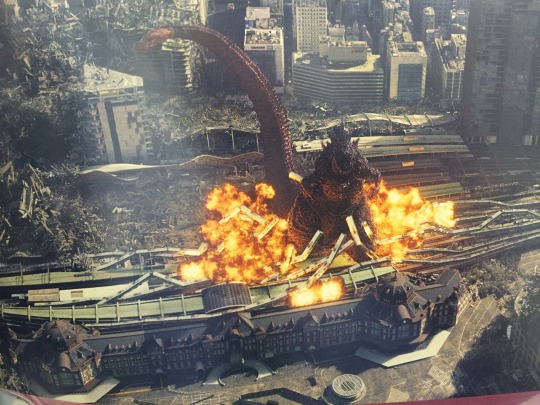
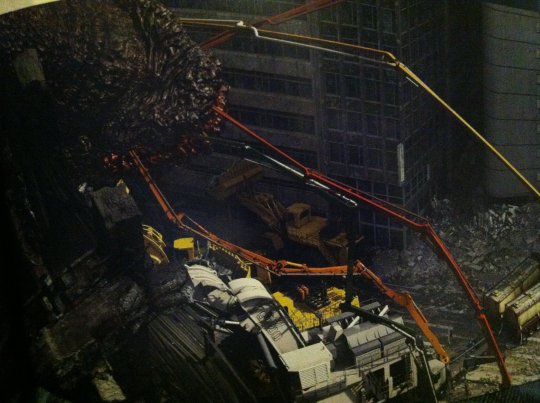
Of course, none of this would have been possible if a team of Japanese scientists and officials who do not conform to their institutions had not been grouped together to find a solution. There’s a power to the bureaucracy, the film argues, in coordinating responses among different agencies and in bringing together the outsiders and non-conformists, and there is a role for the “lone-wolves, nerds, troublemakers, outcasts, academic heretics, and general pains in the bureaucracy” in any organization.
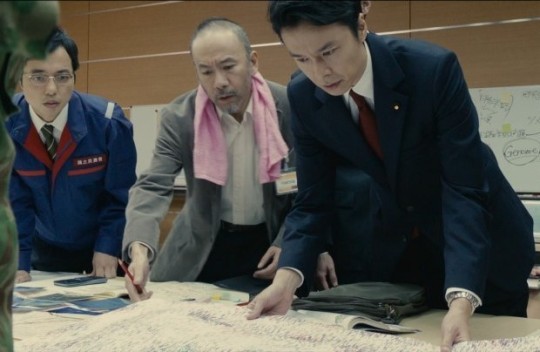
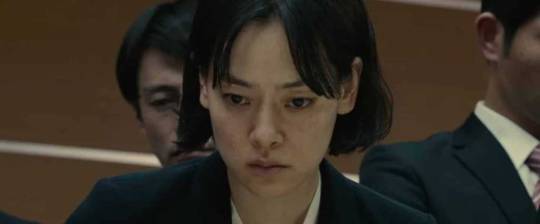
The film is similarly conflicted about Japan’s relationship with the United States. American officials are almost always depicted as faceless voices that demand from afar, sending a half-Japanese liaison, Satomi Ishihara’s Kayoko Ann Patterson, to connect with the Japanese crisis team. Ultimately, Patterson sides with the Japanese government at her own risk at a critical moment, prompting the idea that even those who are of Japanese descent living outside Japan are crucial to Japan’s future. Japanese officials are frustrated by American interference in their affairs; the American government goes so far as to propose using a thermonuclear weapon on Godzilla, which horrifies every Japanese official and even Patterson. In the end, the film taps into the renewed sense of Japanese nationalism by showing that Japanese officials can only move forward to solve the Godzilla problem by going their own way, defying the American attempt to take charge, and solving their problem their way.
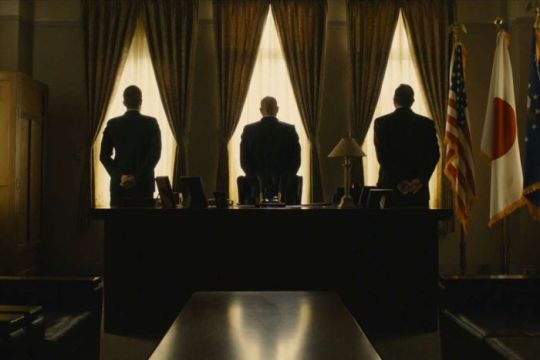
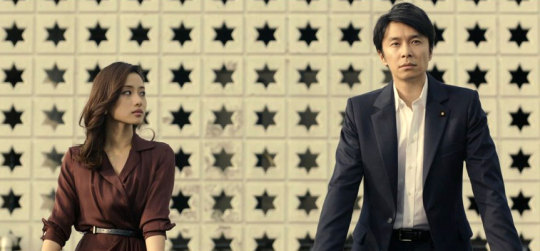
(There’s probably an essay to be written about how the film treats its three principal female characters: Kayoko Ann Patterson, Mikako Ichikawa’s Deputy Director of Nature Conservation Bureau Hiromi Ogashira, and Kimiko Yo’s Defense Minister Reiko Hanamori. Hiromi and Patterson are probably around the same age, and they’re equally outsiders. Patterson is the American half-Japanese liaison, while Hiromi is outspoken and somewhat socially awkward. Patterson is much more conscious about her physical appearance, while Hiromi wears no make-up at all. Reiko stands apart from them both; older than both other women, Reiko is a senior official in the Japanese cabinet and the military’s voice for the Prime Minister.)
Anno, Higuchi, and composer Shiro Sagisu also layer in plenty of homages for Evangelion fans. Based on my impressions, I’ve found these callbacks:
The use of the track “Decisive Battle” from the Evangelion soundtrack to spice up scenes of men and women working in conference rooms
The way the film places a visual emphasis on Japanese trains
The way Anno and Higuchi framed their shots of tanks, aircraft, and artillery pieces bombarded Godzilla in the same ways that they attacked Angels throughout Evangelion
The way they focused on Godzilla’s eyes to show its monstrosity in the same way they focused on Eva-01′s eyes to show its near-humanity
The way the final shot echoed the Failures of Infinity in the Evangelion: 3.0+1.0 teaser trailer at the end of Evangelion 3.33
The way the lights turned out in the underground shelter echoed the way the lights went out during an Angel attack
The way Godzilla attacked all around him echoed the way Ramiel defended itself in Evangelion 2.0
The way Godzilla’s blood plopped to the ground echoed the way various Angels’ blood would fall after they were killed
The way military officials were framed when they released their attacks on Godzilla/the Angels were ineffective
The Japanese Twitter user named “bakashinji” who had an Asuka avatar.

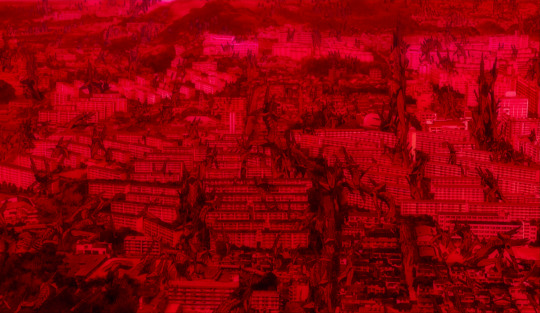
While the film is dialogue heavy, it never feels slow. And it’s a surprisingly funny film, from Godzilla’s googly eyes in its first appearances to the way that an official’s title becomes a visual gag in subtitles because it takes up almost half the screen.

It was everything that I had hoped for from a film by Anno and Higuchi: satirical, strangely hopeful, dynamically shot, wonderfully scored. In other words,
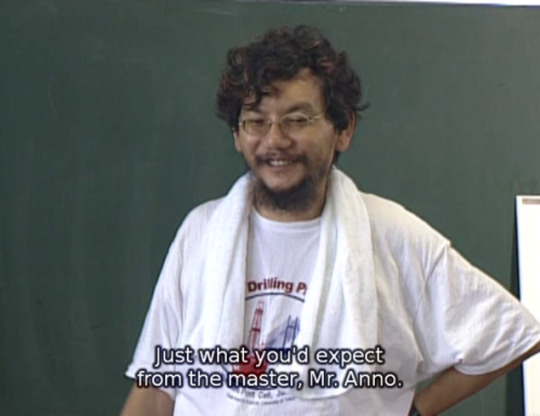
#shin godzilla#hideaki anno#shinji higuchi#shiro sagisu#godzilla#kaiju#hiroki hasegawa#yutaka takenouchi#ishihara satomi
182 notes
·
View notes
Text
do I want a plot where Rockefeller gets shot with a doohickeymadoodle like Shinzo Abe? Maybe??????? Who am I kidding of course I want a plot where Rockefeller gets shot with a doohickeymadoodle
-----
Also, Opium Wars but the Chinese have a giant mecha for some reason
Now that I am more comfortable drawing robots maybe I will do GIANT MECHA FIGHTS OPIUM WARS sometime.
I WILL NEVER STOP MENTIONING THE OPIUM WARS
FUCK YOU BRITAIN.
Can anyone recommend me a steampunk-type setting story where it has more cyberpunk-y vibes. I want something with more thought than "slap brass paint and gears on it.¹"
Like swap in colonialism or robber barons for the megacorps.
I mean the massive corruption and the wealth inequality is already there.
¹ THE 19TH CENTURY WAS THE RISE OF SYNTHETIC DYES. THEY INVENTED MAUVEINE. IF ANYTHING IT SHOULD BE JUST AS HOT PINK AS CYBERPUNK IS. I WILL DIE ON THIS HILL. AND DON'T FORGET THE ARSENIC GREEN.
#someone liked this post and I was thinking about it again#Mech Fights Opium Wars has legit haunted my brain for yeeeaarrrssss
15 notes
·
View notes